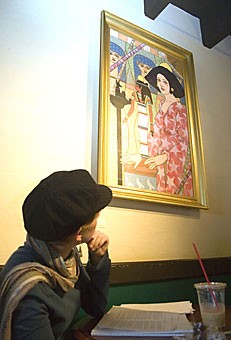While most local galleries and coffee shops exhibit a distinctly modern cadre of artwork along their walls, Espresso Art on University Boulevard is paying homage to an almost forgotten era of painting: Art Nouveau.
An exhibition by Tucson artist Richard Jarvis shows women from a myriad of cultures posed and dressed in fashions inspired by women’s magazines from 1919. Egyptians, American flappers, Hawaiian women and Japanese geishas all come together to make a point about womanhood throughout history, and how women have lost a certain grace after two World Wars.
“”There’s something nostalgic, almost romantic about it,”” Jarvis said. “”There’s a common thread of female beauty that runs throughout eternity. Different worlds that have gone away. We don’t recognize it while it’s happening to us. There’s almost something sad – a moment in time of reflection as a woman looking out into the world.””
The figures may be dressed flamboyantly, but all have a certain complacent look on their faces. Their bodies are firmly outlined in black like the paintings of early 1900s Czech master Alfons Mucha, but unlike his paintings, their lips are pursed and their eyes distracted.
“”They’re beautiful to watch, and the way they do things (also),”” Jarvis said. “”There’s something innately beautiful in the attraction. These things are ceremonies, which we seem to have lost now.””
In “”Woman with a Teacup,”” a pale brunette in a turtleneck stares out from her seat in a coffee shop, her hair an amorphous bundle of brown scribbles flowing down toward her neck. Her dark lips are juxtaposed with her white face in a reminder of the geisha paintings sitting across the hall.
In “”Maikio,”” two Japanese girls, one in makeup and the other without, gesture to each other inside a supremely decorated room. A paper lantern pokes out of the orange excess from the top right, completing the lavishness of the scene. The women are dressed in ceremonial kimonos that complement their bodies, and the made-up one has orange rosy cheeks that highlight her delicacy.
Jarvis, who has lived in Cairo, Egypt, likes to paint women who depict Egyptian history as well. Many of his paintings are based around the Nile, where the lavishness of city life became a constant force in fashion.
For his Japanese collection, he thinks of the road between Kyoto and Tokyo.
Much of the history of his inspiration is used as a contrast to the contemporary American way of life.
“”I think we’re vulgar, I think we really are,”” Jarvis said. “”The attire’s irrelevant. The lack of common decency and manners – it’s overlapped into our personal lives in every level. Formalized manners sometimes help you to navigate through life.””
Jarvis said he refuses to wear blue jeans because they symbolize an American uniform and the status quo. He’s also skeptical of art schools that push conformity, and doesn’t accept any criticism for painting in an anachronistic style.
“”There’s an awful lot of the same thing, and it’s all coming out of universities and magazines,”” Jarvis said.
Of the figures in his artwork, he said, “”They’re saying that you will be shadows like us someday, so don’t be afraid of the beautiful things around you.””
Jarvis’ works are a part of Espresso Art’s permanent collection, but come and go depending on the other exhibitions the shop has lined up.









